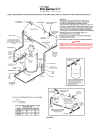
4
SHOULD OVERHEATING OCCUR OR THE GAS SUPPLY FAIL
TO SHUT OFF, TURN OFF THE MANUAL GAS CONTROL
VALVE TO THE APPLIANCE.
Heater must be protected from freezing downdrafts during
shutdown periods.
GROUNDING INSTRUCTIONS
This water heater must be grounded in accordance with the
National Electric Code and/or local codes. These must be followed
in all cases.
This water heater must be connected to a grounded metal,
permanent wiring system; or an equipment grounding conductor
must be run with the circuit conductors and connected to the
equipment grounding terminal or lead on the water heater.
CHEMICAL VAPOR CORROSION
WARNING
CORROSION OF THE FLUEWAYS AND VENT SYSTEM MAY
OCCUR IF AIR FOR COMBUSTION CONTAINS CERTAIN
CHEMICAL VAPORS. SUCH CORROSION MAY RESULT IN
FAILURE AND RISK OF ASPHYXIATION.
Spray can propellants, cleaning solvents, refrigerator and air
conditioning refrigerants, swimming pool chemicals, calcium and
sodium chloride (water softener salt), waxes, and process
chemicals are typical compounds which are potentially corrosive.
Do not store products of this sort near the heater. Also, air which
is brought in contact with the heater should not contain any of
these chemicals. If necessary, uncontaminated air should be
obtained from remote or outside sources. The limited warranty is
voided when failure of water heater is due to a corrosive
atmosphere. (Refer to the limited warranty for complete terms
and conditions.)
LIQUID PETROLEUM MODELS
Water heaters for propane or liquefied petroleum gas (LPG) are
different from natural gas models. A natural gas heater will not
function safely on LP gas and no attempt should be made to
convert a heater from natural to LP gas.
LP gas must be used with great caution. It is highly explosive
and heavier than air. It collects first in low areas making odor
difficult to detect at nose level. If LP gas is present or even
suspected, do not attempt to find the cause yourself. Go to a
neighbor’s house, leaving your doors open to ventilate the house,
then call your gas supplier or service agent. Keep area clear
until a service call has been made.
At times you may not be able to smell an LP gas leak. One cause
is odor fade, which is a loss of the chemical odorant that gives LP
gas its distinctive smell. Another cause can be your physical
condition, such as having a cold or diminishing sense of smell
with age. For these reasons, the use of a propane gas detector
is recommended.
IF YOU EXPERIENCE AN OUT-OF-GAS SITUATION, DO NOT
TRY TO RELIGHT APPLIANCES YOURSELF. Only trained LP
professionals should conduct the required safety checks in
accordance with industry standards.
HIGH ALTITUDE INSTALLATIONS
WARNING
INSTALLATIONS ABOVE 2000 FEET REQUIRE REPLACEMENT
OF THE BURNER ORIFICE IN ACCORDANCE WITH SECTION
8.1.2 OF THE NATIONAL FUEL GAS CODE (ANSI Z223.1). FOR
CANADIAN INSTALLATIONS CONSULT CANADIAN
INSTALLATION CODES AND CAN/CGA B149. FAILURE TO
REPLACE THE ORIFICES WILL RESULT IN IMPROPER AND
INEFFICIENT OPERATION OF THE APPLIANCE RESULTING
IN THE PRODUCTION OF INCREASED LEVELS OF CARBON
MONOXIDE GAS IN EXCESS OF SAFE LIMITS WHICH COULD
RESULT IN SERIOUS PERSONAL INJURY OR DEATH.
You should contact your gas supplier for any specific changes
which may be required in your area.
As elevation above sea level is increased, there is less oxygen
per cubic foot of gas. Therefore, the heater input rate should be
reduced at high altitudes for satisfactory operation with the reduced
oxygen supply. Failure to make this reduction could result in an
overfiring of the heater, causing sooting, poor combustion and/or
unsatisfactory heater performance.
U.S. REQUIREMENTS
Ratings specified by manufacturers for most appliances apply for
elevations up to 2000 feet (610m). For elevations above 2000
feet (610m), ratings must be reduced at the rate of 4% for each
1000 feet (305m) above sea level. For example, if a heater is
rated at 120,000 Btuh (35 Kwh) at sea level, to rate the heater at
4000 feet (1219m), you subtract 4 (once for each thousand feet)
x .04 (4% input reduction) x 120,000 (original rating) from the
original rating. Therefore, to calculate the input rating at 4,000
feet (121.9m): 4 x .04 x 120,000=19,200 Btuh (5.6 Kwh), 120,000
(35 Kwh) - 19,200 (5.6Kwh)=100,000 Btuh (29.4 Kwh). At 6000
feet (1829m) the correct input rating should be 91,200 Btuh (26.7
Kwh).
CANADIAN REQUIREMENTS
Appliances with inputs up to and including 400,000 BTU (117.2
Kw) must be factory equipped with orifices for operation at specific
elevations. Standard (sea level) orifices permit operation up to
2000’ (610m) elevation. For operation between 2000’ (610m)
and 4500’ (1370m) specify “HIGH ALTITUDE OPERATION” when
ordering the heater(s). For operation above 4500’ (2370m) consult
factory before ordering.
Field conversion for operation at altitudes other than that
specified on the heater rating plate is not permitted.
The input reduction is primarily achieved by reducing the size of
the main burner orifice. To do this, the main burner orifices require
replacement with orifices sized for the particular installation
elevation. Correct orifice sizing and parts may be obtained from
A.O. Smith Water Products Company. When ordering, be sure
to state the model number and the altitude of the location where
the water heater is being installed.
Upon completion of derating of the heater, adjustment to the gas
pressure regulator may be required. See CHECKING THE INPUT
section in this manual for inlet and manifold pressure
requirements.
Also due to the input rating reduction required at high altitudes,
the output rating of the appliance is reduced and should be
compensated for in the sizing of the equipment for the application.


















